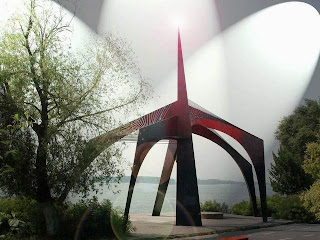| Galaţi (pronounced [gaˈlaʦʲ]) is a city in Moldavia, eastern Romania, the capital city of Galaţi County on the banks of the Danube, very close to Brăila forming with it the Cantemir metropolitan area. In 2002, according to the official Romanian census, the city had a population of 298,861 people, making it Romania's 7th largest city. |
| Name: The name of the city appears to have derived from Cuman galat, which was borrowed from the Arabic qal'at (fortress). Also other etymologies were suggested, such as the Serbian galac; however the galat root appears in several nearby toponyms, some of which show clearly a Cuman origin, for example Gălăţui Lake, which has the typical Cuman -ui suffix for "water". A derivation from Galatia (Gaul), suggesting a Celtic origin, is possible, but unlikely. |
| History: The first mention of the city dates from 1445. In 1789, during the Russo-Turkish War, Galaţi was burnt down by the Russian forces led by general Mikhail Kamensky. |
| Galaţi 1826 |
| A peasant revolt took place in and around the city in 1907, but eventually it was crushed by the authorities. |
| Tourist sights: Galaţi has a fine 20th century Romanian Orthodox cathedral - St. George (Sfântu Gheorghe) and another particularly striking fortified church (that of St. Mary - Sf. Precista) on the banks of the Danube, which was built in 1647 by Vasile Lupu (legend has it that a tunnel was dug from the church and under the river).Other features of the city include a botanical garden, several museums, a television tower opened to the public and offering full view of the city, the newly-restored Galaţi Opera House, and a sculpture park lining a promenade of several kilometres along the banks of the Danube. |
| Remarkable architectural structures: Galaţi TV Tower (Romanian: Turnul de televiziune Galaţi), a 150-metre tall telecommunication tower built of concrete, also used for FM broadcasting |
| Education: Galaţi has a university, the "Dunărea de Jos" University, founded in 1951 as a Naval and Mechanical Engineering Institute and given university status in 1974, by merging the Polytechnical Institute (the successor of the initial Institute) with the College of Education (founded in 1959). The city also a host to other educational and cultural institutions; among these, the "Vasile Alecsandri" and "Mihail Kogălniceanu" National Colleges rank as the first pre-university level educational institutions in Galaţi and the country. |
| Economy: The city has the largest iron and steel plant in Romania the Arcelor-Mittal Galaţi, state-owned until 2001. It is still commonly referred to under the old name "Sidex". Also, the country's largest shipyard on Danube is located here, benefiting from the good access Galaţi has to the Black Sea through the Danube and the short distance between its facilities and the Mittal Plant. |
| Galaţi in fiction: In Bram Stoker's novel Dracula, Galaţi (Galatz) is the port at which Count Dracula disembarked ship on his escape back to Transylvania |
Images from my garden, Oil paint pictures, Wood art, Collection, My point of view and Facts.
Search this Blog or Google Search
Translate this page by selecting the language from bellow link
Galati Romania- My Hometown
Subscribe to:
Comments (Atom)



















Very nice!
ReplyDelete